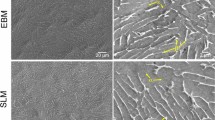Abstract
The use of aluminum alloys for automotive heat exchangers has increased considerably in the last 15 to 20 years, and in parallel, new alloys have been developed to meet the increased demand for higher strengths and improved corrosion resistance. An Al-Mn alloy, X800, has been developed by Alcan to significantly increase the corrosion resistance of radiator tubes when subjected to typical service environments. Conventional alloy tubes, 3xxx or 6xxx, fail by intergranular attack, whereas X800 utilizes the diffusion of Si during brazing to form a sacrificial layer between core and cladding and thus prevent penetration through the core. The Si penetrates up to a depth of 70 µm into the core alloy and combines with both the Mn in solid solution and the coarse constituent particles to form theα-AlMnSi phase. In contrast to the core, the interface layer exhibits a high dispersoid density, a modified coarse particle chemistry, and a lower Mn level in solid solution after brazing. Three layers remain after brazing; anα-Al residual cladding, the interface layer with a band of dense precipitates (BDP), and the X800 core. Free corrosion potential measurements confirmed the lowering of the potential within the BDP by about 30 mV compared to —710 mV for the brazed X800 core.
Similar content being viewed by others
References
G. Winkhaus: inAluminium Technology ’86, T. Sheppard, ed., Institute of Metals, London, 1986, pp. 2–13.
P. E. Fortin, P. H. Marois, and D. G. S. Evans: U. S. Patent 5,037,707, Aug 1991.
D. J. Schmatz:Weld. Res. Suppl., 1983, No. 10, pp. 267–71.
K. D. Wade and D. H. Scott: inAluminium Technology ’86, T. Sheppard, ed., Institute of Metals, London, 1986, pp. 521–27.
W. D. Finegan: U. S. Patent 4,586,964, May 1986.
P. R. Miller: U. S. Patent 2,821,014, Jan 1958.
R. A. Woods, A. C. Scott, and J. F. Harris: “A Corrosion Resistant Alloy for Vacuum Brazed Aluminium Heat Exchangers,” Society for Automotive Engineers, Detroit, MI, 1991, paper no. 910591.
G. J. Marshall: Ph. D. Thesis, University of Leeds, Leeds, England, 1981.
7992Annual Book of ASTM Standards, ASTM G85-85, 1992, pp. 357–61.
M. Cooper and K. Robinson:Acta Cryst., 1966, vol. 20, pp. 614–17.
H. D. Merchant, T. Z. Kattamis, and G. Scharf: inHomogenisation and Annealing of Aluminium and Copper Alloys, H. D. Merchant, I. Crane, and E. H. Chia, eds., TMS, Warrendale, PA, 1988, pp. 1–53.
H. Warlimont:Aluminium, 1977, vol. 53, pp. 71–76.
L. F. Mondolfo:Aluminium Alloys, Structure and Properties, Butterworth’s Sevenoaks, United Kingdom, 1976, p. 594.
Author information
Authors and Affiliations
Rights and permissions
About this article
Cite this article
Marshall, G.J., Bolingbroke, R.K. & Gray, A. Microstructural Control in an Aluminum Core Alloy for Brazing Sheet Applications. Metall Trans A 24, 1935–1942 (1993). https://doi.org/10.1007/BF02666328
Received:
Published:
Issue Date:
DOI: https://doi.org/10.1007/BF02666328




